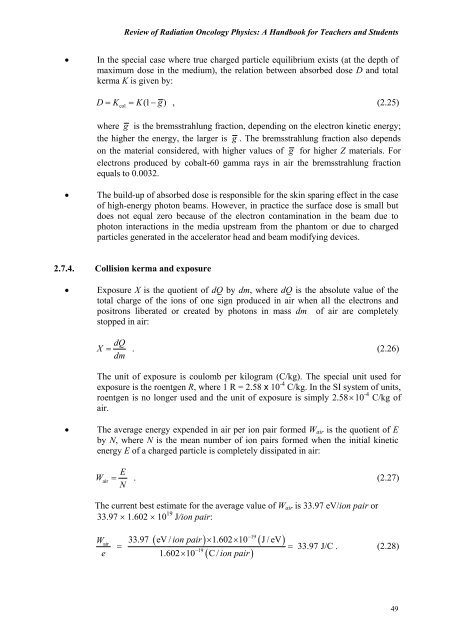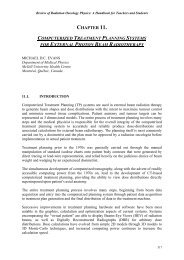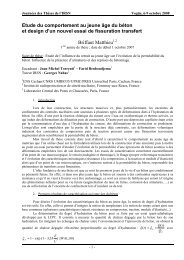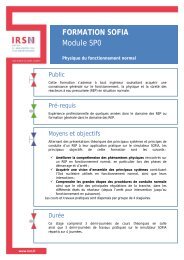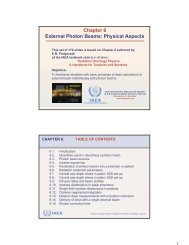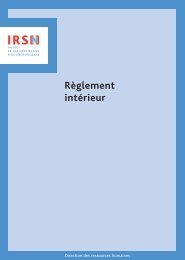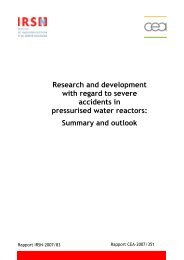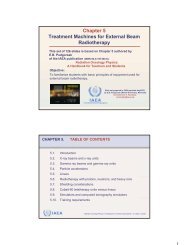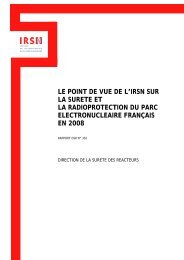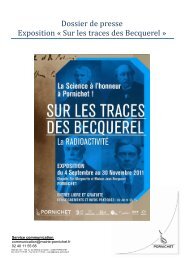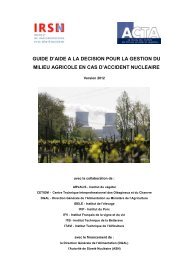chapter 2. dosimetric principles, quantities and units - IRSN
chapter 2. dosimetric principles, quantities and units - IRSN
chapter 2. dosimetric principles, quantities and units - IRSN
You also want an ePaper? Increase the reach of your titles
YUMPU automatically turns print PDFs into web optimized ePapers that Google loves.
Review of Radiation Oncology Physics: A H<strong>and</strong>book for Teachers <strong>and</strong> Students• In the special case where true charged particle equilibrium exists (at the depth ofmaximum dose in the medium), the relation between absorbed dose D <strong>and</strong> totalkerma K is given by:D= Kcol = K(1 − g), (<strong>2.</strong>25)where g is the bremsstrahlung fraction, depending on the electron kinetic energy;the higher the energy, the larger is g . The bremsstrahlung fraction also dependson the material considered, with higher values of g for higher Z materials. Forelectrons produced by cobalt-60 gamma rays in air the bremsstrahlung fractionequals to 0.003<strong>2.</strong>• The build-up of absorbed dose is responsible for the skin sparing effect in the caseof high-energy photon beams. However, in practice the surface dose is small butdoes not equal zero because of the electron contamination in the beam due tophoton interactions in the media upstream from the phantom or due to chargedparticles generated in the accelerator head <strong>and</strong> beam modifying devices.<strong>2.</strong>7.4. Collision kerma <strong>and</strong> exposure• Exposure X is the quotient of dQ by dm, where dQ is the absolute value of thetotal charge of the ions of one sign produced in air when all the electrons <strong>and</strong>positrons liberated or created by photons in mass dm of air are completelystopped in air:XdQ= . (<strong>2.</strong>26)dmThe unit of exposure is coulomb per kilogram (C/kg). The special unit used forexposure is the roentgen R, where 1 R = <strong>2.</strong>58 x 10 -4 C/kg. In the SI system of <strong>units</strong>,roentgen is no longer used <strong>and</strong> the unit of exposure is simply <strong>2.</strong>58×10 -4 C/kg ofair.• The average energy expended in air per ion pair formed W air is the quotient of Eby N, where N is the mean number of ion pairs formed when the initial kineticenergy E of a charged particle is completely dissipated in air:WairE= . (<strong>2.</strong>27)NThe current best estimate for the average value of W air is 33.97 eV/ion pair or33.97 × 1.602 × 10 19 J/ion pair:Weair−19( ion pair) × × ( )−191.602×10 ( C / ion pair)33.97 eV / 1.602 10 J / eV= =33.97 J/C .(<strong>2.</strong>28)49


